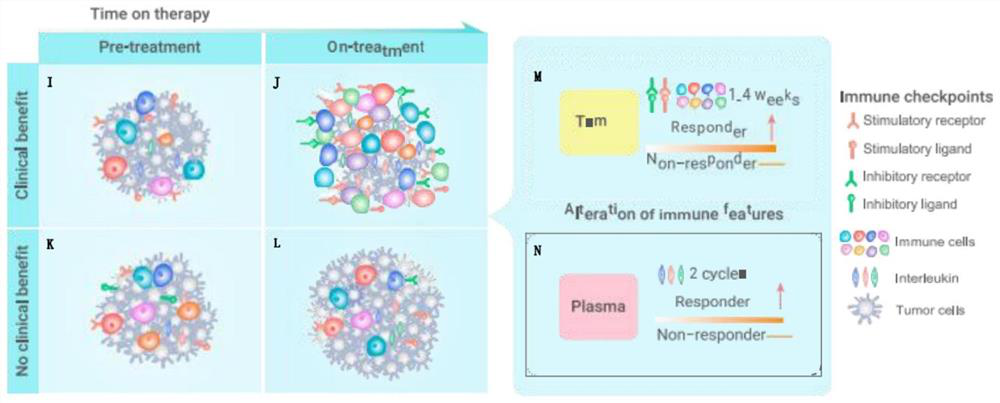Immunotherapy curative effect prediction marker and prediction model construction and application
An immunotherapy and predictive model technology, applied in the field of immunotherapy, can solve the problem of little understanding of the impact of biomarker accuracy, and achieve the effect of wide applicability and improved accuracy
- Summary
- Abstract
- Description
- Claims
- Application Information
AI Technical Summary
Problems solved by technology
Method used
Image
Examples
Embodiment 1
[0023] Such as figure 1 Shown:
[0024] Using bioinformatics analysis to systematically analyze the cancer genome atlas (The Cancer Genomics Atlas) contains 33 cancers, metastatic tumor data sets of more than 1000 samples, as well as 14 active and 20 independent ICB treatment data sets Pairwise correlations between the expression of suppressed immune checkpoints, as well as the abundance of various types of immune cells, suggest that these immune signatures are in homeostasis ( figure 1 A-B); where (A) samples were collected from primary tumors, metastatic tumors, and ICB-treated patients; (B) the relationship between activated and inhibited checkpoints and the relative abundance of immune cell populations. (C) Clinical impact of treating patients with ICB by non-invasive kinetic analysis of blood samples; (D) proof-of-concept evidence for kinetic analysis in plasma to predict response to immunotherapy;
[0025] Further comparing the changes of immune characteristics in TIME...
Embodiment 2
[0027] Such as Figure 1-2 shown
[0028] Clinically, in two independent anti-PD-1 monoclonal antibody lung cancer treatment cohorts, the expression of ILs in the plasma of patients after 2 cycles (4-6 weeks) after the start of treatment was detected, and a model for predicting the efficacy of immunotherapy was established ( figure 1 D. figure 2 A-E), and validate the model accuracy in different datasets ( figure 2 F-H). This method is non-invasive, low-cost and high-efficiency, and can evaluate the curative effect of ICB in the early stage of treatment, which is earlier than traditional detection methods based on imaging, and is a new paradigm for dynamically predicting the curative effect of immunotherapy.
[0029] Such as figure 2 A dynamic map of immune signatures predicting response to immunotherapy is shown. (A) Schematic of sample collection from lung cancer patients treated with anti-PD-1 alone or chemotherapy and anti-PD-1 combined. (B) Differences in IL expre...
PUM
 Login to View More
Login to View More Abstract
Description
Claims
Application Information
 Login to View More
Login to View More - Generate Ideas
- Intellectual Property
- Life Sciences
- Materials
- Tech Scout
- Unparalleled Data Quality
- Higher Quality Content
- 60% Fewer Hallucinations
Browse by: Latest US Patents, China's latest patents, Technical Efficacy Thesaurus, Application Domain, Technology Topic, Popular Technical Reports.
© 2025 PatSnap. All rights reserved.Legal|Privacy policy|Modern Slavery Act Transparency Statement|Sitemap|About US| Contact US: help@patsnap.com



